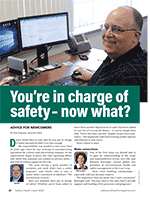Are you a ‘safety cop’?
Try a different approach, experts say

Early in his career, Steven Perkins would encounter co-workers not wearing their hard hats or engaging in other unsafe behaviors.
His response was to be direct, telling them what they needed to do.
Or, “If I saw something even more egregious, I might go straight to their supervisor and tell them to halt the work until they corrected the problem.”
Perkins learned, though, that this approach led to people tuning him out. “You try to tell a 20- or 30-year veteran contractor how to do their job. They don’t particularly care for that approach,” said the business unit safety director at Minneapolis-based ERM, a consultancy firm. “So you end up just sort of feeling like, ‘Gosh, I keep nagging these people. I keep telling them and half of my day is spent just going around trying to correct their behaviors.’”
He fell into a trap that can ensnare many safety professionals, especially inexperienced ones: becoming a “safety cop.”
Perkins said that although some safety pros may believe their job – much like that of a law enforcement officer – is to make sure workers are following the rules, their primary role is actually to influence behavior.
“It’s how we intervene that really matters. Your primary role is to try to influence. You can’t do that by saying, ‘This is the rule. Follow it.’”
Steven Perkins
Business unit safety director
ERM
Focus on thoughts, not actions
One reason why the “safety cop” approach doesn’t work is that it focuses on controlling workers’ actions instead of addressing the thoughts and motivations behind them.
“Every action that you take is driven by thought,” Perkins said. “So, if you’re trying to get them to change how they act, you have to get them to change how they think as well. There are a number of reasons why people might choose to do something unsafe. And unless we understand that reason, we’re not going to really be able to say much effectively to them.”
For example, an employee may have the intention of working safely, but a tight production schedule can push them to rush or take shortcuts.
Co-presenting with Perkins at the 2019 National Safety Council Congress & Expo, Matthew Botzler – a regional environmental, health and safety manager at the chemicals company Johnson Matthey – pointed out other reasons why workers might choose to take unsafe actions: lack of hazard recognition, normalization of risk and the “illusion of invulnerability.” He used a veteran forklift driver as an example.
“They’ve been operating that forklift for 35 years. It’s like their own hand,” Botzler said. “They have a sense an incident isn’t going to happen to them because they’re good at their job. They have pride in their work. But the fact is we’re all human and we all make mistakes. Sooner or later, chances are something is going to catch up with them.”
Mike Mangan, vice president of solution development for DEKRA’s consulting practice, added that people are often sensitive to status, which includes experience on a job. When a safety pro who’s never done a worker’s job tries to tell them how to do it, that can lead to resistance.
When that happens to a worker, “all of a sudden, I’m at a different status than you are,” Mangan said. “I may be the person that’s senior, I’ve got a lot of expertise in this job. And who are you, this new safety person, to tell me?”
More experienced workers may also be more vulnerable to status quo bias. We all tend to stick to our routines and can be resistant to change, even if it puts us at risk.
And don’t forget the temptation of shortcuts, which can be attractive because they may make it easier and faster to get the job done. Workers may view procedures such as donning personal protective equipment as a time-consuming hurdle or extra step.
“You’re fighting against this natural positive consequence of taking a shortcut,” Mangan said.
Be a safety coach instead
To counteract that, become a safety coach instead of a safety cop, Perkins said. That means engaging in a respectful dialogue with workers instead of simply pointing out what they’re doing wrong.
“That’s especially important when you’re dealing with someone who has a lot more experience or a different skill set or a different perspective. You don’t want to sort of run right over them. You want to make sure that you yield to that different level of experience and that you’re respectful with it.”
During those conversations, you can acknowledge your concern for the employee’s safety while building a rapport with them.
Perkins said a significant step in being a safety coach is getting workers to think about, see and own safety issues. One way to do that is by asking open-ended questions.
For example, say an employee is about to use a ladder. You’d start with general questions such as, “So, can you tell me about what you’re doing?” Later on, you could ask, “Do you have any safety concerns when you’re doing this? What are they?”
Try to avoid using accusatory language, such as “wrong” or “problem,” in your questioning.
 In an article published in the April issue of Safety+Health (“You’re in charge of safety – now what?”), Danny Smith, a senior safety consultant at SafeStart, said that, at a former job, he’d assign self-inspections to employees from certain areas of the plant – tasking them with using the same checklist he did, or filling out a portion of it. This helped the workers understand what to look for and get them engaged in safety.
In an article published in the April issue of Safety+Health (“You’re in charge of safety – now what?”), Danny Smith, a senior safety consultant at SafeStart, said that, at a former job, he’d assign self-inspections to employees from certain areas of the plant – tasking them with using the same checklist he did, or filling out a portion of it. This helped the workers understand what to look for and get them engaged in safety.
“Ultimately,” Perkins said, “the goal is to get them to identify the hazard and then collaborate about the best way or ways to manage that hazard. That way it becomes our collective safety concern, not your individual one that you’re imposing on them.”
By engaging in a dialogue and asking questions, you can appear less judgmental while building trust and bringing down any walls among employees. Both sides also can come up with ways that policies and procedures can work even more effectively.
For instance, you can say: I notice you’re not wearing your safety glasses. Is there something going on with the glasses that makes it difficult to work? Are they fogging up?
“You have to listen to them and understand why they’re doing something that way,” Perkins said. “Because often, if I understand the cause or the reasons why they’re doing it that way, then we can have a better, more productive dialogue.”
On the flip side, telling people what to do or micromanaging them can lead to disengagement, which can adversely affect productivity and other areas.
Dialogue, messaging on safety
During those dialogues and while asking questions, you can take the time to make safety personal for the employee. Ask: What if something happened here? How would that affect your loved ones or friends? How would an injury affect what you like to do off the job?
“People can easily buy into safety if they understand how it benefits them,” said Crystal Cannan, director of workplace training and survey services at NSC.
Messaging from safety pros and leaders can play a significant role in making safety more personal. Instead of, “Wear your safety glasses,” Mangan said, “Protect your eyes” is a more meaningful message because it gives the reason for wearing the PPE instead of just a rule to follow.
An example from Perkins: roadway construction signs that read, “Slow down! My mom/dad works here.” He said: “Our conversation should be like that: explaining the importance of the rule, why the rule is there and the value of it, and not just reminding them of the rules. A lot of the people we talk to, they know the rules, so reminding them of the rules is not going to be very effective.”
More advice
At that same former job, Smith said, he and his employees worked on team-building skills to help generate a safer work environment.
“What I found was, when the team was working well together, they would be safer. When they had good team dynamics, they would be more reliant on each other to actually say, ‘Hey, we’ve got a problem over here,’ or ‘We need to do this or we need to do that.’”
More advice:
- Don’t jump to conclusions when you see something wrong, Perkins said. Stop and listen first. (One notable exception is any imminent danger situation, which requires quick action.) “One of the things we always say is don’t assume the worst of people,” he said. “Most people aren’t intentionally trying to cause a safety incident or get themselves hurt. They’re not trying to be unsafe. If you immediately judge them or just think they’re being careless or don’t care, or they’re just lazy or taking a shortcut because they’re somehow inherently ‘bad people,’ that mindset certainly doesn’t lend itself to creating a collaborative dialogue and that won’t lead to a long-term sustainable change in their behaviors.
- If you have to have a conversation about unsafe behavior, Perkins recommends having it one-on-one instead of in a group setting. “Don’t call them out in front of people or make them lose face in front of their peers.”
- If conversations and other methods aren’t working and an employee continues to disregard safety measures, then progressive discipline, in accordance with company policy, may be in order. However, that should be a last resort, Perkins noted.
- After each interaction, thank employees for their time and their commitment to safety. “Let them know they’re appreciated and they’ve been heard,” Perkins said.
When it comes to interacting with workers, Mangan has one more piece of advice: Get to know them. It can help you grow as a safety pro. “Your ability to influence is enhanced when you really know a worker’s perspective and see the world from their view.”
Post a comment to this article
Safety+Health welcomes comments that promote respectful dialogue. Please stay on topic. Comments that contain personal attacks, profanity or abusive language – or those aggressively promoting products or services – will be removed. We reserve the right to determine which comments violate our comment policy. (Anonymous comments are welcome; merely skip the “name” field in the comment box. An email address is required but will not be included with your comment.)

